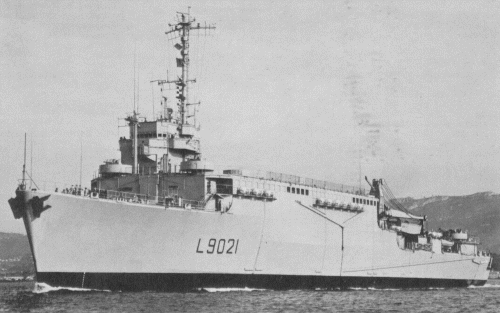
NAVYPEDIA
 Support the project with paypal
Support the project with paypal
Photo

Ouragan 1980
Ships
| Name | No | Yard No | Builder | Laid down | Launched | Comp | Fate |
|---|---|---|---|---|---|---|---|
| Ouragan | L9021 | Arsenal de Brest | 20.6.1962 | 9.11.1963 | 1.6.1965 | stricken 7.2009 | |
| Orage | L9022 | Arsenal de Brest | 6.1966 | 22.4.1967 | 1.4.1968 | stricken 7.2009 |
Technical data
| Displacement standard, t | 5800 |
|---|---|
| Displacement full, t | 8500 |
| Length, m | 144.5 pp 149.0 oa |
| Breadth, m | 21.5 |
| Draught, m | 5.40 min |
| No of shafts | 2 |
| Machinery | 2 SEMT-Pielstick 12PC-2V diesels |
| Power, h. p. | 8640 |
| Max speed, kts | 17 |
| Fuel, t | diesel oil |
| Endurance, nm(kts) | 8000(15) |
| Armament | L9021: 2 x 1 - 120/12 mortars, 4 x 1 - 40/60 Mk 3, 3 - 13 helicopters on deck (3 Super Frelon or 10 Alouette on main helicopter deck and 1 Super Frelon or 3 Alouette on portable platform) L9022: 2 x 1 - 120/12 mortars, 3 - 13 helicopters on deck (3 Super Frelon or 10 Alouette on main helicopter deck and 1 Super Frelon or 3 Alouette on portable platform) |
| Military load | 2 EDIC (with 11 light tanks each) or 18 LCM(6) or 1500t of cargo or 18 Super Frelon helicopters or 80 Alouette II helicopters, 470 troops, 3 LCVP |
| Electronic equipment | L9021: DRBN-32 radar, SQS-17 sonar L9022: DRBN-32 radar |
| Complement | 211 |
Standard scale images

Ouragan 1980
Graphics
Project history
Designated TCD (Transports de Ćhalands de Débarquement) these two vessels were designed with a dual function in mind. They can lift a full commando and its support troops and put them ashore using helicopters; and they can put ashore personnel, tanks, vehicles and supplies using landing craft. While the design was clearly influenced by the American LSD concept, an increase in flexibility was obtained, particularly with regard to the operation of helicopters and the accommodation of vehicles by the use of removable sections of deck both externally and internally.
The docking well was 120m long, and floods to a depth of 3m. The stern gate measured 14x5.5m. Two EDICs, each with a capacity of eleven light tanks, or eighteen LCM(6)s can be accommodated. Movement of the water control sluices and valves was automatic, using pumps controlled from a central command post. A temporary deck 90m long in fifteen sections can be laid out to increase the stowage space for vehicles or cargo, but the well was then reduced to half its original size. In the logistics role, 1500t of equipment can be carried, the cargo being handled by two 35t cranes mounted above the docking well. Alternative loads included eighteen Super Frelons, eighty Alouettes, 120 AMX-13 tanks, eighty-four DUKWs, 340 jeeps or twelve 50t barges.
Instead of the conventional LSD superstructure there was a small island to starboard which accommodated the navigation bridge and a combined centre for directing amphibious and helicopter operations. The main helicopter deck was designed to operate either three Super Frelon troop-carrying helicopters or ten Alouettes. A further Super Frelon or three Alouettes can be operated from a removable deck in six sections which covers the after part of the well for 36m. A total of 349 troops can be transported (470 over short distances), and three LCVPs were carried topsides.
The TCDs were intended to serve as repair and maintenance ships on distant deployments. They can dock a 400t ship and were equipped with hull and machinery repair shops, and electrical and ordnance workshops.
Modernizations
1992, Ouragan: - 2 x 1 - 40/60, DRBN-32 radar, SQS-17 sonar; + 2 x 2 Simbad SAM (8 Mistral), DRBN-34 radar
1992, Orage: - DRBN-32 radar; + 2 x 2 Simbad SAM (8 Mistral), 2 x 1 - 30/82 OTOBreda-Mauser Model F (fitted for, but never installed), DRBN-34 radar
Naval service
No significant events.
 HOME
HOME FIGHTING SHIPS OF THE WORLD
FIGHTING SHIPS OF THE WORLD FRANCE
FRANCE AMPHIBIOUS SHIPS AND CRAFT
AMPHIBIOUS SHIPS AND CRAFT OURAGAN dock landing ships (1965 - 1968)
OURAGAN dock landing ships (1965 - 1968)
